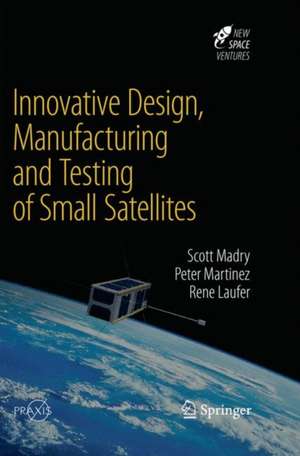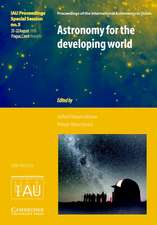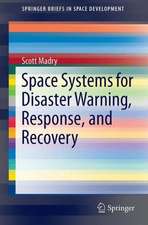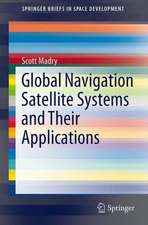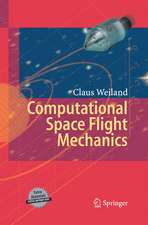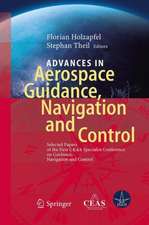Innovative Design, Manufacturing and Testing of Small Satellites: Springer Praxis Books
Autor Scott Madry, Peter Martinez, Rene Lauferen Limba Engleză Paperback – 26 dec 2018
The explosive growth in the design, manufacturing, and launch of small satellites is one of the most dynamic aspects in the area of space exploration and exploitation today. New commercial space companies such as Planet Labs, Sky Box, OneWeb, and LeoSat are now building and launching thousands of small satellites and cubesats into orbit. Small companies and big aerospace companies alike are getting into this exciting and interesting new business.
This is a practical guide that provides advice to students, researchers, LEO satellite companies, and regulators wrestling with some of the new challenges that small satellites present as more and more companies and countries around the world enter the new small satellite arena.
| Toate formatele și edițiile | Preț | Express |
|---|---|---|
| Paperback (1) | 492.19 lei 38-44 zile | |
| Springer International Publishing – 26 dec 2018 | 492.19 lei 38-44 zile | |
| Hardback (1) | 723.74 lei 38-44 zile | |
| Springer International Publishing – 25 mai 2018 | 723.74 lei 38-44 zile |
Din seria Springer Praxis Books
-
 Preț: 294.46 lei
Preț: 294.46 lei -
 Preț: 223.45 lei
Preț: 223.45 lei -
 Preț: 193.12 lei
Preț: 193.12 lei -
 Preț: 167.85 lei
Preț: 167.85 lei -
 Preț: 288.98 lei
Preț: 288.98 lei -
 Preț: 323.74 lei
Preț: 323.74 lei -
 Preț: 401.38 lei
Preț: 401.38 lei -
 Preț: 264.12 lei
Preț: 264.12 lei - 8%
 Preț: 513.00 lei
Preț: 513.00 lei -
 Preț: 190.01 lei
Preț: 190.01 lei -
 Preț: 218.16 lei
Preț: 218.16 lei -
 Preț: 312.06 lei
Preț: 312.06 lei - 17%
 Preț: 414.05 lei
Preț: 414.05 lei -
 Preț: 216.41 lei
Preț: 216.41 lei -
 Preț: 262.27 lei
Preț: 262.27 lei -
 Preț: 264.35 lei
Preț: 264.35 lei -
 Preț: 167.63 lei
Preț: 167.63 lei -
 Preț: 284.81 lei
Preț: 284.81 lei -
 Preț: 259.08 lei
Preț: 259.08 lei -
 Preț: 305.47 lei
Preț: 305.47 lei -
 Preț: 244.14 lei
Preț: 244.14 lei -
 Preț: 227.85 lei
Preț: 227.85 lei -
 Preț: 285.25 lei
Preț: 285.25 lei -
 Preț: 295.56 lei
Preț: 295.56 lei -
 Preț: 357.17 lei
Preț: 357.17 lei -
 Preț: 275.79 lei
Preț: 275.79 lei -
 Preț: 257.08 lei
Preț: 257.08 lei -
 Preț: 349.71 lei
Preț: 349.71 lei -
 Preț: 272.45 lei
Preț: 272.45 lei -
 Preț: 270.27 lei
Preț: 270.27 lei - 8%
 Preț: 456.51 lei
Preț: 456.51 lei -
 Preț: 352.34 lei
Preț: 352.34 lei - 8%
 Preț: 394.80 lei
Preț: 394.80 lei -
 Preț: 320.65 lei
Preț: 320.65 lei -
 Preț: 325.29 lei
Preț: 325.29 lei -
 Preț: 253.11 lei
Preț: 253.11 lei -
 Preț: 192.86 lei
Preț: 192.86 lei -
 Preț: 313.40 lei
Preț: 313.40 lei -
 Preț: 150.51 lei
Preț: 150.51 lei -
 Preț: 233.34 lei
Preț: 233.34 lei -
 Preț: 286.78 lei
Preț: 286.78 lei -
 Preț: 212.01 lei
Preț: 212.01 lei -
 Preț: 366.83 lei
Preț: 366.83 lei -
 Preț: 299.99 lei
Preț: 299.99 lei -
 Preț: 232.27 lei
Preț: 232.27 lei -
 Preț: 284.58 lei
Preț: 284.58 lei -
 Preț: 212.45 lei
Preț: 212.45 lei -
 Preț: 159.81 lei
Preț: 159.81 lei -
 Preț: 349.48 lei
Preț: 349.48 lei - 20%
 Preț: 2061.64 lei
Preț: 2061.64 lei
Preț: 492.19 lei
Preț vechi: 607.64 lei
-19% Nou
Puncte Express: 738
Preț estimativ în valută:
94.21€ • 102.37$ • 79.19£
94.21€ • 102.37$ • 79.19£
Carte tipărită la comandă
Livrare economică 18-24 aprilie
Preluare comenzi: 021 569.72.76
Specificații
ISBN-13: 9783030091484
ISBN-10: 3030091481
Pagini: 161
Ilustrații: XV, 161 p. 45 illus., 43 illus. in color.
Dimensiuni: 155 x 235 mm
Greutate: 0.27 kg
Ediția:Softcover reprint of the original 1st ed. 2018
Editura: Springer International Publishing
Colecția Springer
Seriile Springer Praxis Books, Astronautical Engineering
Locul publicării:Cham, Switzerland
ISBN-10: 3030091481
Pagini: 161
Ilustrații: XV, 161 p. 45 illus., 43 illus. in color.
Dimensiuni: 155 x 235 mm
Greutate: 0.27 kg
Ediția:Softcover reprint of the original 1st ed. 2018
Editura: Springer International Publishing
Colecția Springer
Seriile Springer Praxis Books, Astronautical Engineering
Locul publicării:Cham, Switzerland
Cuprins
Preface.- Acknowledgements.- Chapter 1: Introduction to the World of Small Satellites.- Chapter 2: Engineering, Design, and Launch Arrangements of Smallsats.- Chapter 3: Smallsats for Remote Sensing -- The Swarm is Here!.- Chapter 4: Innovative New Uses of Smallsats for Networking and Telecom.- Chapter 5: Small Satellites and the U.N. Sustainable Development Goals.- Chapter 6: Future Prospects and Policy Concerns.- Chapter 7: Potential Innovations in Space Regulatory Systems and Standards.- Chapter 8: Conclusions and Top Ten Things to Know About Small Satellites.- Appendix 1: Glossary of Terms and Acronyms.- Appendix 2: The Space Debris Mitigation Guidelines of the U.N. Committee on the Peaceful Uses of Outer Space.- Appendix 3: Resolution Adopted by the General Assembly Convention on Registration of Objects Launched into Outer Space.- Appendix 4:Convention on International Liability for Damage Caused by Space Objects.- Appendix 5: IADC Space Debris Mitigation Guidelines.- Index.
Notă biografică
Dr. Rene Laufer is working at the Institute of Space Systems of the University of Stuttgart, Germany, in collaboration with the Space Lab in the Department of Electrical Engineering at the University of Cape Town in South Africa. He is project manager of the Stuttgart small moon satellite “Lunar Mission BW1”. Rene’s areas of expertise include astronomical, lunar and planetary exploration and systems engineering. The special focus of his systems engineering skill is in optimizing the design for small scientific satellite missions and arranging for their launch. His current research interests are thus focused on small satellite technology and development, future lunar and planetary exploration and utilization as well as Earth observation. Until 2003 Rene worked for nearly ten years at German Aerospace Center (DLR) in planetary exploration supporting missions in different roles. Rene graduated in Aerospace Engineering at Technical University of Berlin, Germany, and received his PhD from the University of Stuttgart. Also he was a freelancer in event management and actively involved with the Berlin Planetarium and Observatory for more than ten years in lecturing. Being also an alumnus of the International Space University (ISU) he returns to the ISU regularly since 2004 for teaching. He is involved in small satellite related conferences and symposia and is one of the chairs of the IAA Permanent Small Satellite Committee.
Professor Peter Martinez has been appointed to coordinate the Space Studies Program at UCT. Prior to joining UCT he was centrally involved in a number of developments leading to the reinvigoration of the South African space program. Professor Martinez was previously with the South African Astronomical Observtory, a facility operated by the National Research Foundation. He is the current chairman of the South African Council for Space Affairss and has extensive experience in multilateral space diplomacy through his involvement with the U. N. Committee on the Peaceful Uses of Outer Space, where he chairs its workinng group on the long-term sustainability of outer space activities. he is a member of the International Academy of Astronautics and of the International Institute of Space Law.
Dr. Scott Madry is the Executive Director of the Global Space Institute. He is the founder and President of Informatics International, Inc. and specializes in the applications of Geomatics technologies for regional environmental and cultural research. He is a long-time member of the faculty of the International Space University, and has served as the program director of the ISU Southern Hemisphere Summer Space Program for four years in Adelaide, Australia, as well as teaching in some twenty-four ISU programs around the world.
He received his Ph.D. from UNC-Chapel Hill (Chapel Hill, North Carolina, USA) in 1986 and then worked for three years at the Institute for Technology Development, Space Remote Sensing Center at the NASA Stennis Space Center (Mississippi, USA). He then took the position of Senior Associate Director of the Center for Remote Sensing and Spatial Analysis at Rutgers University (New Jersey, USA), where he taught for nine years in the Anthropology, Geography, and Natural Resources departments. He is widely published and recently was an editor for the 1,300 page, two-volumeHandbook of Satellite Applications for Springer Press. He is a two-time Fulbright Scholar, having taught in France and South Africa in the Fulbright Specialist Program.He has conducted research in North America, Europe, and Africa, and has given over 150 short courses and seminars in over thirty countries around the world. He has consulted for numerous governments, corporations and non-profits, and has received over US$7.5 million in grants and contracts. Dr. Madry has acted as a consultant on satellite remote sensing for a major Hollywood film, and has been a consultant formajor museum exhibitions on the subject. Some of his research was featured in the McGraw Hill Yearbook of Science and Technology in 1991. In 1997 he was awarded the Russian Tsiolkovsky Gold Medal for his international research and teaching activities. He is currently conducting work in North Carolina, USA, Florida, USA, Rwanda, and France. He is very active in American Red Cross Disaster Services, and has won several awards for his activities on behalf of the Red Cross. In 2012 he was awarded, along with the other members of the GISCorps, the President’s Volunteer Service Award by United States President Barak Obama for his work in applying geomatics technologies to disaster management.
Professor Peter Martinez has been appointed to coordinate the Space Studies Program at UCT. Prior to joining UCT he was centrally involved in a number of developments leading to the reinvigoration of the South African space program. Professor Martinez was previously with the South African Astronomical Observtory, a facility operated by the National Research Foundation. He is the current chairman of the South African Council for Space Affairss and has extensive experience in multilateral space diplomacy through his involvement with the U. N. Committee on the Peaceful Uses of Outer Space, where he chairs its workinng group on the long-term sustainability of outer space activities. he is a member of the International Academy of Astronautics and of the International Institute of Space Law.
Dr. Scott Madry is the Executive Director of the Global Space Institute. He is the founder and President of Informatics International, Inc. and specializes in the applications of Geomatics technologies for regional environmental and cultural research. He is a long-time member of the faculty of the International Space University, and has served as the program director of the ISU Southern Hemisphere Summer Space Program for four years in Adelaide, Australia, as well as teaching in some twenty-four ISU programs around the world.
He received his Ph.D. from UNC-Chapel Hill (Chapel Hill, North Carolina, USA) in 1986 and then worked for three years at the Institute for Technology Development, Space Remote Sensing Center at the NASA Stennis Space Center (Mississippi, USA). He then took the position of Senior Associate Director of the Center for Remote Sensing and Spatial Analysis at Rutgers University (New Jersey, USA), where he taught for nine years in the Anthropology, Geography, and Natural Resources departments. He is widely published and recently was an editor for the 1,300 page, two-volumeHandbook of Satellite Applications for Springer Press. He is a two-time Fulbright Scholar, having taught in France and South Africa in the Fulbright Specialist Program.He has conducted research in North America, Europe, and Africa, and has given over 150 short courses and seminars in over thirty countries around the world. He has consulted for numerous governments, corporations and non-profits, and has received over US$7.5 million in grants and contracts. Dr. Madry has acted as a consultant on satellite remote sensing for a major Hollywood film, and has been a consultant formajor museum exhibitions on the subject. Some of his research was featured in the McGraw Hill Yearbook of Science and Technology in 1991. In 1997 he was awarded the Russian Tsiolkovsky Gold Medal for his international research and teaching activities. He is currently conducting work in North Carolina, USA, Florida, USA, Rwanda, and France. He is very active in American Red Cross Disaster Services, and has won several awards for his activities on behalf of the Red Cross. In 2012 he was awarded, along with the other members of the GISCorps, the President’s Volunteer Service Award by United States President Barak Obama for his work in applying geomatics technologies to disaster management.
Textul de pe ultima copertă
This book details key trends involving the recent formation of scores of companies that build and launch small satellites or provide key components for small satellite constellations. The applications and usage are quite diverse and include student experiments, serious scientific experimentation, and totally new types of commercial constellations, particularly in telecommunications and remote sensing.
The explosive growth in the design, manufacturing, and launch of small satellites is one of the most dynamic aspects in the area of space exploration and exploitation today. New commercial space companies such as Planet Labs, Sky Box, OneWeb, and LeoSat are now building and launching thousands of small satellites and cubesats into orbit. Small companies and big aerospace companies alike are getting into this exciting and interesting new business.
This is a practical guide that provides advice to students, researchers, LEO satellite companies, and regulators wrestling with some of the new challenges that small satellites present as more and more companies and countries around the world enter the new small satellite arena.
The explosive growth in the design, manufacturing, and launch of small satellites is one of the most dynamic aspects in the area of space exploration and exploitation today. New commercial space companies such as Planet Labs, Sky Box, OneWeb, and LeoSat are now building and launching thousands of small satellites and cubesats into orbit. Small companies and big aerospace companies alike are getting into this exciting and interesting new business.
This is a practical guide that provides advice to students, researchers, LEO satellite companies, and regulators wrestling with some of the new challenges that small satellites present as more and more companies and countries around the world enter the new small satellite arena.
Caracteristici
Explains how the small satellite has dramatically changed in the past decade Provides current and potential practitioners with unique, useful advice on how to design, test, and build small satellites Supports equally attempts by university classrooms and space engineers to build a small satellite for research purposes Includes key information on the new small satellite constellations in terms of their technical characteristics, launch arrangements, and competitive pluses and minuses
